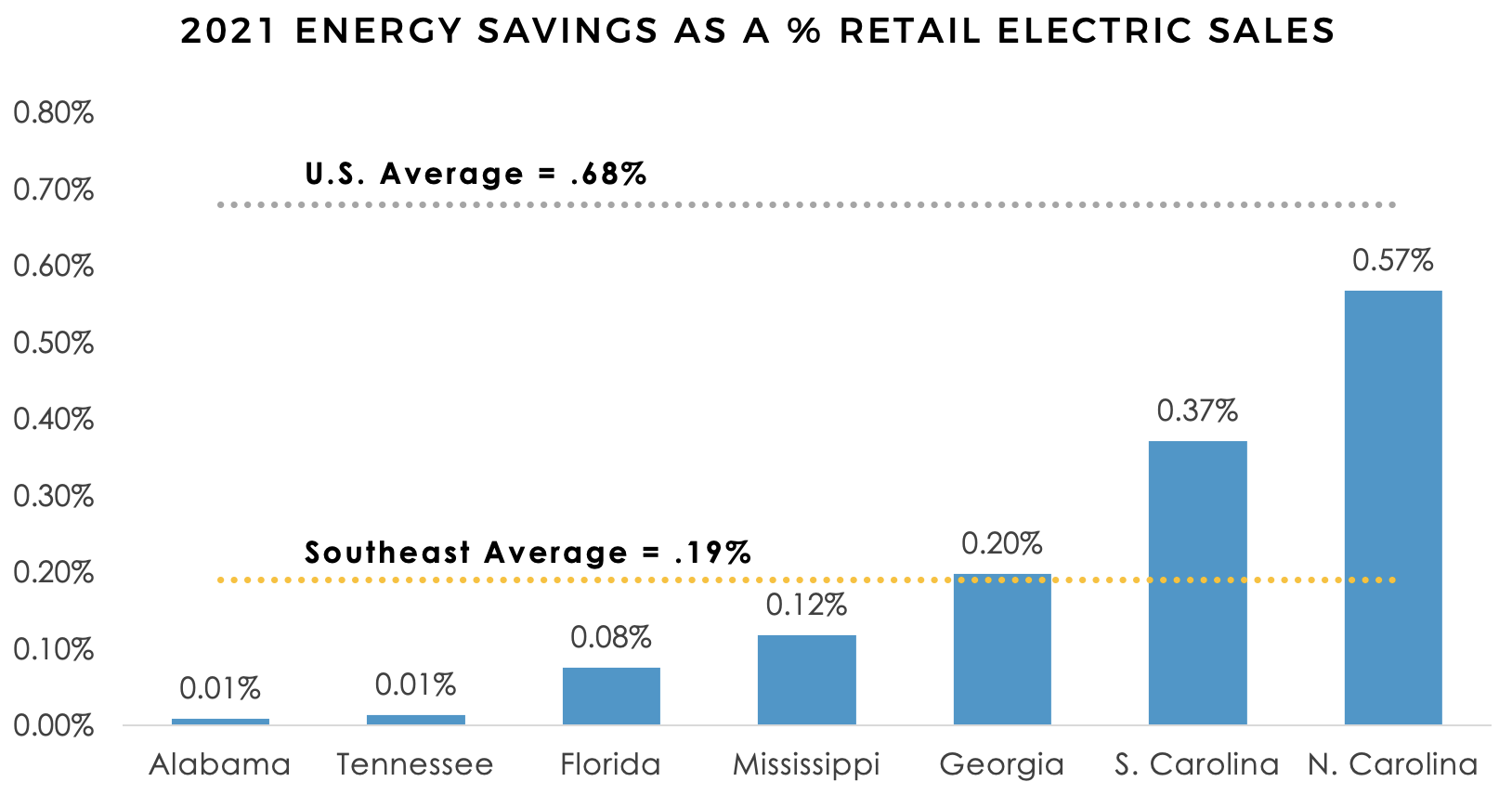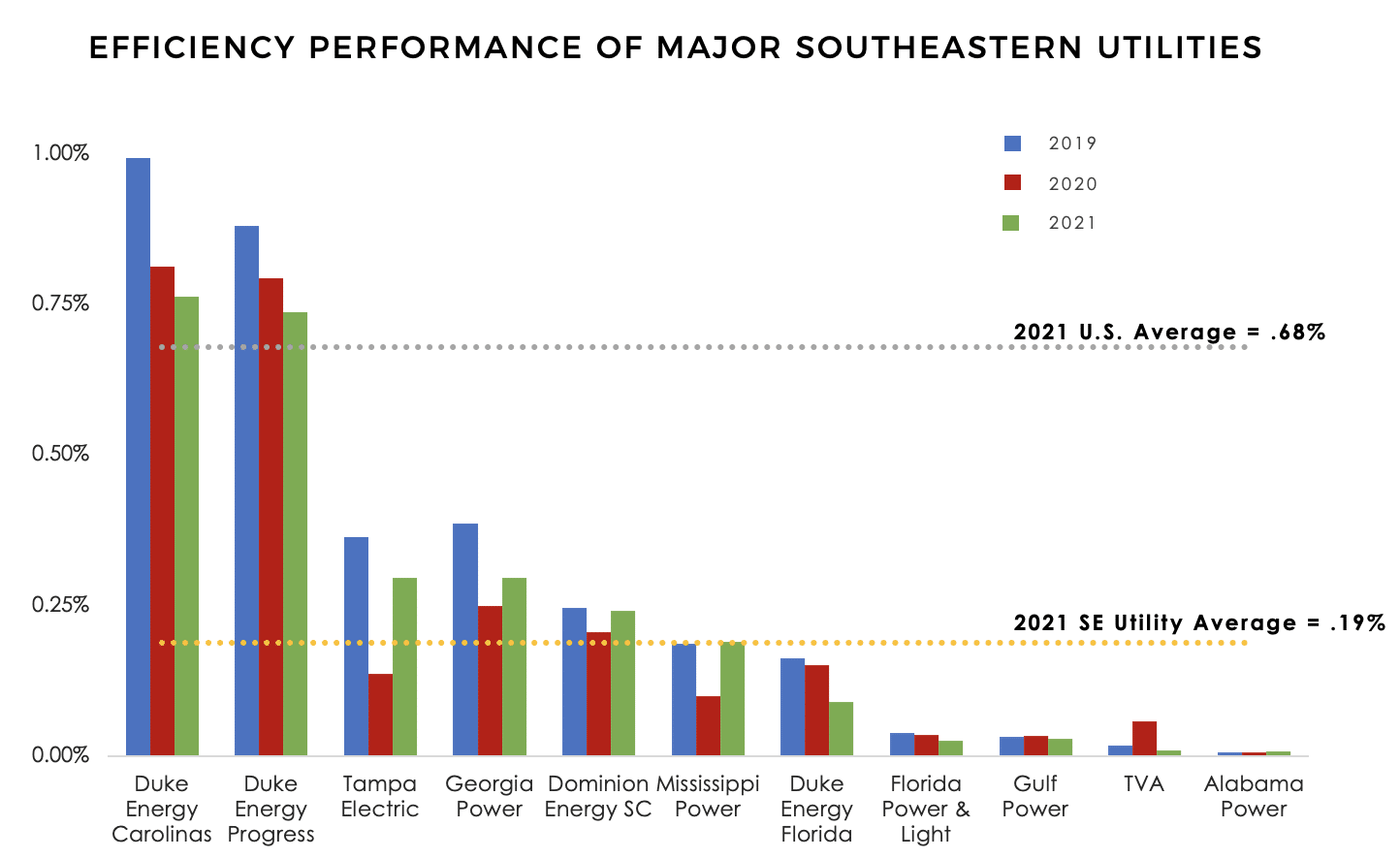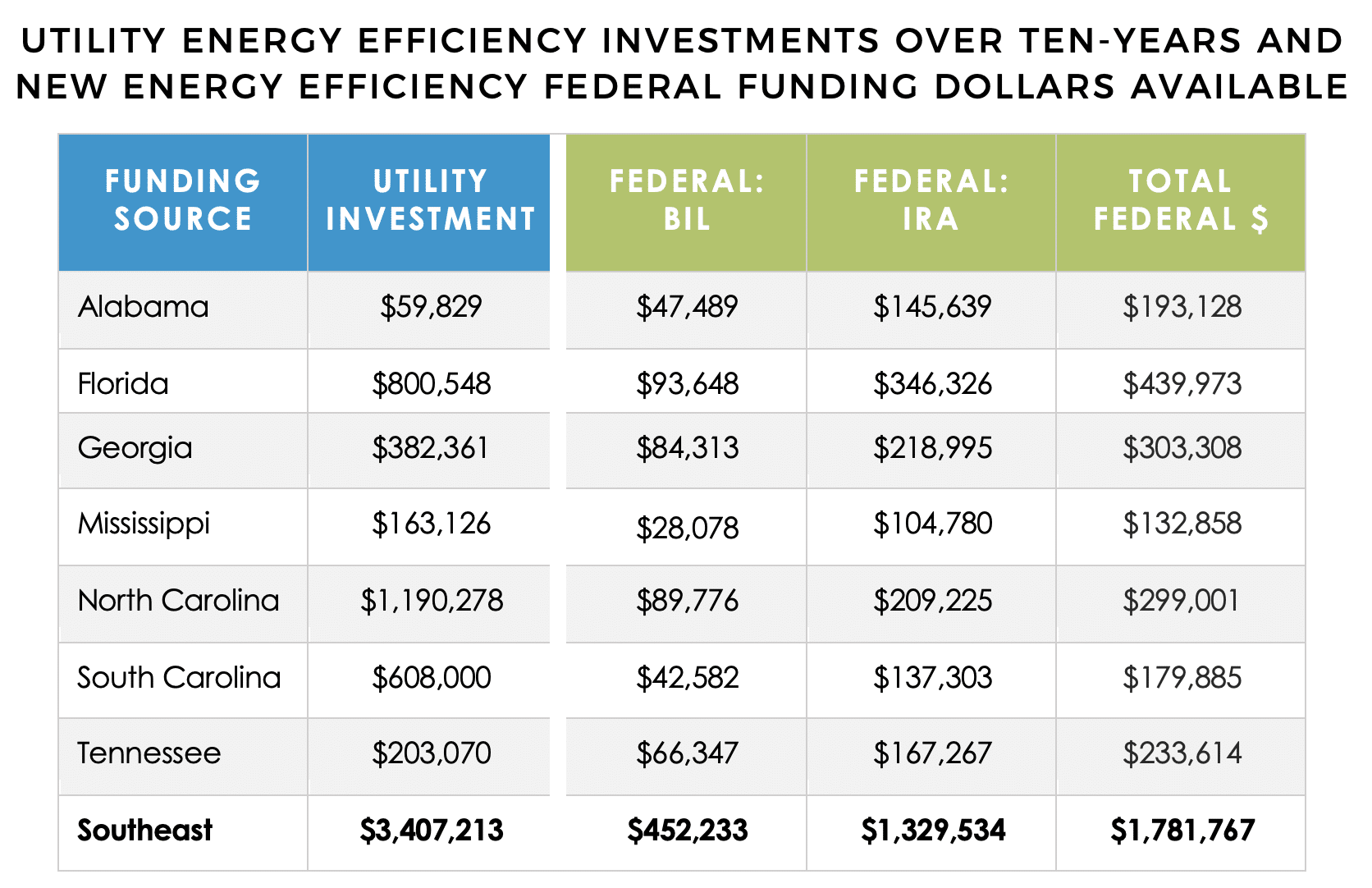Despite years of underinvestment on efficiency in the Southeast, a massive infusion of new federal funding and recent changes in utility resource planning create a once-in-a-generation opportunity to cash in our region's untapped energy efficiency reserves. Doing so now will lower customer energy bills, reduce the costs of shifting to renewables, and accelerate our path toward decarbonization.
Forest Bradley-Wright | March 27, 2023 | Alabama, Energy Efficiency, Energy Policy, Georgia, Mississippi, North Carolina, South Carolina, Tennessee, UtilitiesEach year the Southern Alliance for Clean Energy compiles efficiency performance data from nearly 500 electric utilities in the Southeast. The data and analysis for 2021 are presented here in our fifth annual “Energy Efficiency in the Southeast” report.

Our latest report centers on utility efficiency savings taken as a percent of annual electric retail sales – which creates a standard metric to compare performance between utilities and states of different sizes. Our data findings are presented with both historical context and the most recent policy trends to give a sense of where efficiency savings performance will likely go in the coming years.
Watch the Webinar Read the Report Read the Report Blog Series
Efficiency Performance of the Southeast, States, and Utilities
If our region’s utilities prioritize efficiency in their resource planning, it could help accelerate our shift from fossil fuels to renewable energy, while significantly reducing energy costs to customers. Meanwhile, a massive infusion of federal funding for energy efficiency provides a new driver to accelerate investment in efficiency resources across the Southeast. Despite these potential tailwinds, and despite the fact that efficiency is a proven low-cost clean energy resource, Southeastern utilities and regulators continue to underinvest in and deprioritize it. As a result, households in many Southeastern states have some of the highest electricity usage and monthly energy bills in the nation.

Region-To-Region Comparison
The Southeast has consistently lagged far behind other regions, and the nation as a whole, on utility energy efficiency savings. All regions except the South are above the national average, delivering annual efficiency savings in 2021 that were between four and seven times higher savings than utilities in the Southeast.

The long-term historical deprioritization of energy efficiency does create a future opportunity for the Southeast: while other regions must work harder to find new savings, energy efficiency resources in the Southeast remain inexpensive and abundant- and there has never been a better time to tap these strategic efficiency reserves!
State Rankings
In 2021, efficiency performance in most Southeastern states continued to be lower than pre-pandemic levels. While South Carolina and Georgia saw modest efficiency savings increases over 2020, Tennessee had yet another steep decline, resulting in savings levels that are now 95% lower than they were just five years ago.

Major Utilities in the Southeast
Tampa Electric, Georgia Power, Mississippi Power, and Dominion Energy South Carolina rebounded from deep savings declines in 2020, but Tampa Electric and Georgia Power still trailed their pre-pandemic performance. Duke’s savings continued to decline across the board in 2021, although its savings in the Carolinas continues to be highest in the Southeast. Meanwhile, TVA’s savings fell to the bottom with Alabama Power, and savings remained very low at both Florida Power & Light and Gulf Power (which formally merged in 2022).

Federal Funding Opportunities
The Bipartisan Infrastructure Law (BIL) and Inflation Reduction Act (IRA) of 2022 include unprecedented investment in clean energy, including energy efficiency. These laws make new funding available to individual residents and businesses in the form of rebates and federal tax credits, as well as grants and loans for local governments and rural businesses that can compete for billions of dollars. The Southeast will automatically receive nearly $1.8 billion for energy efficiency programs and customer rebates.

Beyond the automatic funding allocations to states, if citizens and businesses access the new energy efficiency tax credits on a roughly proportionate basis, that would bring an additional $1.9 billion for energy efficiency to the Southeast. Taken together, these funds could roughly equal the amount utilities will spend over the next decade (at their 2021 annual spending levels). It is important that these funds not be administered in silos. To deliver maximum benefit to customers, utility and federal investments in energy efficiency should be leveraged together and delivered in coordination.
Energy Efficiency in Integrated Resource Planning
Demand-side management, which includes energy efficiency, has long been recognized as a least-cost energy resource and a valuable alternative to traditional supply-side power generation. This is because it is often cheaper to help customers cut energy waste than it is to build more expensive power generation. However, not all utility resource planning includes a full and fair comparison between supply-side and demand-side resources. Below are differences in policies and practices for utility resource planning across states, which can either facilitate or impede the expansion of energy efficiency resource options.
- North Carolina has combined its Integrated Resource Plan (IRP) process for Duke’s two utilities into a single proceeding that covers both the IRP and the Carbon Plan every two years, whereby evaluation of resources must meet future needs, reliability requirements, and carbon reduction targets. Carbon reduction targets increase the value of efficiency resources.
- The Georgia Public Service Commission ordered Georgia Power to allow demand response and energy efficiency to compete head-to-head against supply-side resources in its next IRP, in 2025. It is the first state in the Southeast to require this practice, which is well-established in other parts of the country.
- In recent years the South Carolina Public Service Commission has directed utilities to evaluate higher levels of energy efficiency savings, including a requirement that Dominion Energy evaluates savings levels up to 2% of annual retail sales in its 2023 IRP.
- Florida utilities produce an annual Ten Year Site Plan that does not treat efficiency as a resource, which is instead included at historically low efficiency savings levels set in a separate goal-setting process that occurs once every five years.
- The Tennessee Valley Authority essentially eliminated efficiency as a resource in its last IRP, but following a congressional oversight letter in 2021, TVA has promised to do better going forward. Whether or how that will actually happen remains to be seen.
The massive infusion of federal funding for energy efficiency itself has significant implications for future utility resource planning, since these new efficiency savings will lower demand forecasts for decades to come. Stakeholders like SACE will continue to be vigilant to ensure that utilities actually do account for these impacts going forward.
Energy Efficiency in Manufactured Housing
Manufactured housing, also known as mobile homes, are high energy users and prevalent throughout the Southeast. It was a bright spot in the region when the Georgia Public Service Commission directed Georgia Power to fund a cost-effective energy efficiency program focused on retrofitting existing manufactured homes. Mississippi Power has already proposed a similar program, which we hope is the start of a trend throughout the Southeast.
Planning for Energy Efficiency as a Resource Can Lower Electricity Bills and Help Decarbonize the Power Sector
It is high time for the Southeast to cash in on its lucrative and largely untapped energy efficiency reserves! As the least-cost energy resource, increased investment in energy efficiency reduces total utility system costs, making it cheaper to meet customer energy needs and ultimately lowering customer bills.
Energy efficiency is also key to accelerating our transition to an affordable clean energy grid. Efficiency can speed up the retirement of outdated and polluting fossil fuel power plants, while reducing our dependency on fossil gas going forward. It can also make our investment in renewable energy more affordable, and help to maintain grid reliability, including during severe weather incidents.
New federal energy efficiency programs enacted through the BIL and IRA have the potential to substantially accelerate the deployment of energy efficiency in the Southeast. If our region gets its fair share, these new federal programs could at least double efficiency savings in the Southeast relative to existing utility efficiency programs. This once-in-a-lifetime infusion of federal funding for energy efficiency presents a tremendous opportunity, particularly if state agencies and local utilities work together to leverage their combined funding and marketing efforts.
With so many benefits, the key to energy efficiency, quite simply, is to just do it.
Watch the Webinar Read the Report Read the Report Blog Series
#EEReport2023